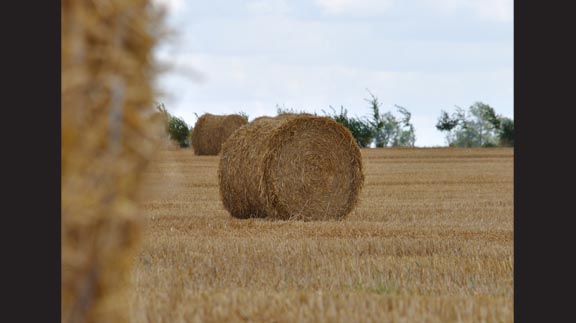Farm & Ranch
For generations, ranchers in the Southern Great Plains have fed their cattle the same way.

For generations, ranchers in the Southern Great Plains have fed their cattle the same way.
During the spring and summer months, cattle graze on a sea of open pastures across the prairie, then in the fall fields begin to go dormant and ranchers typically substitute hay in place of grazing. This can be a pricey endeavor, but this has been the tried-and-true process used for decades.
Today, Noble Foundation launches a new research initiative – Forage365 – aimed at providing a sustainable, year-round grazing system. “Hay is an expensive input for cattle producers,” said Billy Cook, Ph.D., director of the agricultural division. “Regardless of whether a producer makes their own hay or purchases hay, it’s an expensive alternative to grazing. If we can extend the effective grazing period and reduce the need for hay, we can have positive impacts on profitability, and sustainability of ranching operations.
As part of the Forage365 initiative, the Noble Foundation will look to develop a system of forages (plants consumed by grazing animals) that enables ranchers to graze cattle year-round and use less or no hay. Noble Foundation scientists are focusing on four pillar crop species, including alfalfa, bermudagrass, tall fescue, and winter wheat, that could work together as well as with other forages to provide consistent grazing throughout the year.
The Forage365 initiative includes a strategic set of interconnecting projects that will improve forage system productivity and the profitability of livestock production, examine management practices and economic systems, and demonstrate how the system can improve water quality and sustainability. Select outcomes will be available as early as 2018; however, several of the projects are intended to provide building blocks for scientists and breeders to provide improvements over the next decade.
“As a whole, Forage365 focuses on the importance of native and introduced plant species working in a unified system, as well as advancing the use of cover crops,” said Zengyu Wang, Ph.D., director of the forage improvement division. “This whole-system approach enhances the sustainability of grazing lands, taking quality practices by our agricultural producers to the next level.”
The Noble Foundation has been focused on developing better systems and improved plants for forage-based beef cattle systems – the primary agricultural endeavor across Oklahoma and Texas – since its inception in 1945. In the last two years, a year-round grazing system was identified as a strategic objective due to its potential impact on agriculture and the organization’s capacity to achieve this objective.
Forage365 draws together each of the Noble Foundation’s three divisions, including fundamental plant science, plant breeding and management, and applied agricultural researchers, into one cohesive set of projects. Key to the success of this initiative, Noble scientists and researchers will identify and work with external scientists and researchers around the region and nation to expedite the progress.
“The Noble Foundation has the combination of expertise and resources, along with the necessary relationships within the research community, to successfully develop and execute this program,” said Michael Udvardi, Ph.D. “We have a wealth of dedicated individuals at the Noble Foundation and beyond, working together with the ultimate goal of improving agriculture and the environment.”
Farm & Ranch
Ag Elsewhere: Wyoming

By Tressa Lawrence
Babies are tucked away in every nook and cranny. Many ranchers across Wyoming have baby animals popping up all over this time of year.
Farm & Ranch
Ag Elsewhere: Montana

By Lindsey Monk
Another load of grain in to keep feeding the calves until the green grass can really start popping.
Farm & Ranch
Meanwhile, Back at the Ranch….

By Rayford Pullen | [email protected]
Spring has sprung and hopefully the rains will continue where our country will heal from the previous droughts and our grasses will thrive. We are especially hopeful for the Panhandle of Texas where our neighbors and friends have been dealt a deadly blow to homes, ranges, livestock, and people. Keep them in your prayers as they will not be able to return to normal for many years if at all. Having lost their ability to benefit from this great cattle market is a double whammy for all of them.
Now is the time of year when we need to take care of business as it relates to our new calves that have been hitting the ground this spring. First and foremost is vaccinating for Blackleg followed by deworming with a white wormer and the IBR complex. Blackleg is a soil-born disease and with pastures extremely short this spring our calves have been grazing the green grass as soon as it shows itself, making them even more vulnerable to picking contaminates from the soil.
To read more, pick up a copy of the April issue of NTFR magazine. To subscribe by mail, call 940-872-5922.
-

 Country Lifestyles1 year ago
Country Lifestyles1 year agoScott & Stacey Schumacher: A Growth Mindset
-

 Equine7 months ago
Equine7 months agoThe Will to Win
-

 Country Lifestyles7 years ago
Country Lifestyles7 years agoStyle Your Profile – What your style cowboy hat says about you and new trends in 2017
-

 Country Lifestyles4 years ago
Country Lifestyles4 years agoAmber Crawford, Breakaway Roper
-

 HOME7 years ago
HOME7 years agoGrazing North Texas – Wilman Lovegrass
-

 Country Lifestyles7 years ago
Country Lifestyles7 years agoDecember 2016 Profile, Rusty Riddle – The Riddle Way
-

 Country Lifestyles8 years ago
Country Lifestyles8 years agoJune 2016 Profile – The man behind the mic: Bob Tallman
-

 Country Lifestyles8 years ago
Country Lifestyles8 years agoCowboy Culture with Clay Reid – Being a Man






